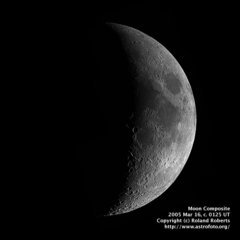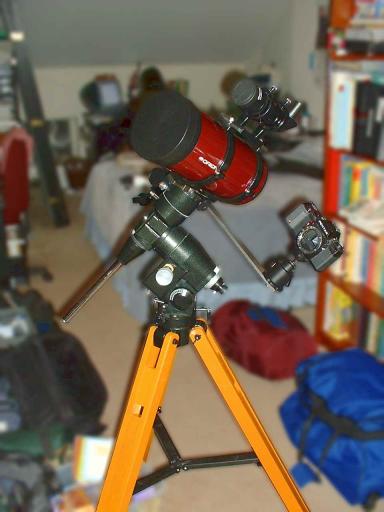Category: Uncategorized
Summer Star Party
Rockland Astronomy Club‘s annual Summer Star Party held in Shady Pines Campground is a family event with a playground, swimming pool, ball fields and local attractions of the Berkshires in western Massachusetts. Alas, Shady Pines closed around 2017 so we moved to Peppermint Park, but that became unavailable in 2020 with the pandemic and we’ve …
127 mm Orion Maksutov-Cassegrain
The 60 mm Tasco was great for getting me started on the road to photography with a good polar alignment. It’s chief failing is its small aperture which leaves me with a small selection of alignment and guide stars. So I went in search of something better (i.e., bigger) I had already found I really …
Northeast Astronomy Forum (NEAF)
The premier astronomy form and show in the northeast US, possibly the whole US. Too many guest speakers and activities (including those for children) to count. See the Rockland Astronomy Club NEAF web page for details.
Total Lunar Eclipse
Two total lunar eclipses in the same year! Well, this one is a tough sell here on the east coast because it starts shortly before moonset and becomes total a mere half hour before moonset. If you missed the event in March and can't wait until the next one in February, find a place with a low western horizon to watch as the moon slowly turns a deep orange and fades into the skyglow at sunrise.
If you live on the west coast or will be traveling there, this eclipse should be a darker one than the event in March since the moon will pass closer to the center of the Earth's shadow than it did in March.
The Rockland Astronomy Club is having a viewing party for this event.
Total Lunar Eclipse
The first total lunar eclipse visible from North America since 27 October 2004 will be in progress at moonrise (5:44pm) here in the northeast USA. In New York City, the moon will already be slightly past it's maximum penetration into the umbra and will only get brighter as the evening progresses. Due to buildings, you probably won't be able to see the moon until after 6:00pm (but that doesn't mean you can't try!).
Sometimes, you might see a deep orange moon at moonrise which quickly becomes white as the moon rises. This is usually due to dust in the atmosphere, but not this night. On March 3rd, the color is due to the sun's light passing through the Earth's atmosphere casting the color of a planet full of sunsets onto the moon.
Take the kids and get out someplace with a low eastern horizon to view the moon as it rises (right at sunset).
About the ending time: don't wait until then! At 6:58pm, the moon will start to emerge from the earth's central shadow (the umbra) and only be partially eclipsed. After that point, it will become increasingly difficult to tell that there is an eclipse at all.
The Rockland Astronomy Club will be hosting a viewing party.
Welcome to astrofoto.org!
 Here you will find the fruits of our hobby. Well, for Maria it is a hobby; for Roland it is closer to an obsession. Still, this is where you will find some of the fruits of that work. In March of 2000, we purchased an 8-inch Newtonian reflector on a Dobsonian mount from Orion Telescopes, the SkyQuest XT8.
Here you will find the fruits of our hobby. Well, for Maria it is a hobby; for Roland it is closer to an obsession. Still, this is where you will find some of the fruits of that work. In March of 2000, we purchased an 8-inch Newtonian reflector on a Dobsonian mount from Orion Telescopes, the SkyQuest XT8.
Using the telescope was a learning experience, especially since time and responsibilities did not allowed us to get to any star parties or meet members from any clubs in the area for nearly a year. Usenet news on sci.astro.amateur was a lifesaver. Most of the time we were viewing from our 3rd story porch in Queens (in the eastern part of New York City). Views to the west were compromised by massive light pollution from Manhattan and during the coldest months the city generates significant heat that ruins the seeing even as high as 60 degrees above the horizon. Still, there are plenty of things which can be seen with the 8-inch scope, or for that matter, with our 10×50 binoculars.
In October of 2002 we moved to Bay Ridge, Brooklyn. We no longer have the 3rd floor porch, but the skies actually seem to be darker. Some of this is because we are near the water which means that in some directions there really is less light pollution. We’ve also acquired some camera equipment and a several telescopes as Roland has gone on a shopping spree (not really, it just kind of accumulates). At this point we have a couple of smaller scopes includeing a 90mm f/5 refractor, its bigger brother, a Orion 120ST 120mm f/5, and older Tasco 60mm f/11 (or so, not quite sure), and an Orion Apex 127mm. And since the imaging bug bit, I’ve acquired a Losmandy GM-8 mount with Gemini GOTO and an older “push-to” Mountain Instruments MI-250 mount. Storage is a problem, but having enough scopes for kids activities is not.
Search
.Archives
- May 2025 (1)
- October 2024 (1)
- May 2024 (2)
- April 2024 (3)
- September 2022 (5)
- April 2022 (1)
- January 2022 (3)
- December 2021 (4)
- September 2021 (3)
- July 2021 (1)
- January 2021 (1)
- November 2020 (2)
- October 2020 (2)
- September 2020 (2)
- August 2020 (5)
- July 2020 (1)
- November 2019 (2)
- September 2019 (1)
- August 2019 (2)
- September 2017 (1)
- August 2017 (1)
- September 2015 (3)
- August 2015 (2)
- June 2015 (5)
- May 2015 (3)
- May 2013 (2)
- January 2013 (1)
- December 2012 (2)
- September 2012 (1)
- June 2012 (1)
- May 2012 (1)
- October 2011 (2)
- September 2011 (2)
- April 2011 (2)
- March 2011 (10)
- January 2011 (8)
- November 2010 (2)
- October 2010 (1)
- September 2010 (3)
- August 2010 (2)
- July 2010 (1)
- June 2010 (1)
- April 2010 (3)
- February 2010 (3)
- January 2010 (3)
- December 2009 (6)
- November 2009 (3)
- October 2009 (7)
- September 2009 (8)
- August 2009 (4)
- July 2009 (1)
- June 2009 (2)
- May 2009 (2)
- April 2009 (7)
- March 2009 (1)
- February 2009 (6)
- January 2009 (4)
- December 2008 (4)
- November 2008 (3)
- October 2008 (11)
- September 2008 (4)
- August 2008 (5)
- July 2008 (5)
- June 2008 (2)
- April 2008 (4)
- March 2008 (18)
- February 2008 (9)
- November 2007 (1)
- October 2007 (3)
- July 2007 (3)
- April 2007 (1)
- March 2007 (6)
- February 2007 (3)
- December 2006 (3)
- October 2006 (4)
- September 2006 (1)
- July 2006 (5)
- May 2006 (10)
- April 2006 (9)

